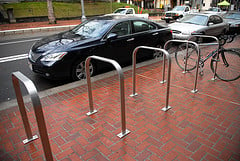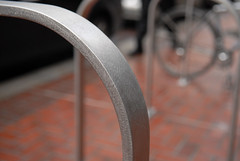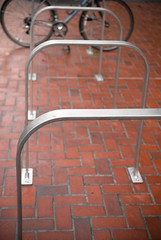The City of Portland has installed 90 stainless steel staple racks as part of the downtown transit mall project.
The racks — designed by architectural firm ZGF — are quite different from the standard blue staple racks. For starters, they’re made from a much more durable (and expensive) stainless steel material. The racks are also made from flat steel stock, compared to the round tube of the existing blue ones.
“The cost of the new stainless steel design is making me count our pennies and have a few more conversations regarding the best use of these funds.”
— Sarah Figliozzi, PBOT
The other big difference is price. According to the Portland Bureau of Transportation’s (PBOT) bike parking manager Sarah Figliozzi, the cost of the new stainless steel racks is $367 each, compared with about $80 each for the old ones (costs do not include installation).
The new rack design was chosen by TriMet and the project’s urban design consultants. “These racks will be the design standard rack for the Transit Mall,” Figliozzi wrote in an email, “in order to ensure a consistent style.”
When I followed-up with Figliozzi, and with city bike coordinator Roger Geller, I found out that that “consistent style” is causing a bit of budget pain at PBOT.
The transit mall project is primarily funded through the federal government, which has set strict guidelines about what “street furniture” can be included in the project. According to Figliozzi, the project calls for (and therefore can fund) around 90 new racks — bringing the total cost for them on the bus mall to $33,000 (not including installation).
“Isn’t it about time cyclists be given their due with the same kind of quality facilities that other downtown parking improvements get?”
— Bob Hastings, TriMet agency architect
Figliozzi, and PBOT bike coordinator Roger Geller both realize that the mall’s approximately 6 miles of block faces need much more than 90 racks. Figliozzi says they plan to augment that number, but that at $367 a piece, they have to choose wisely.
“The point of the new transit mall is to re-invigorate downtown, to have lots of retail activity,” she told me on the phone last week, “ideally we’d have tons of parking”.
But, Figliozzi says, “The cost of the new stainless steel design is making me count our pennies and have a few more conversations regarding the best use of these funds.” She also added that she’ll “have to be more careful” about where they decide to put them. “Ideally, we like to put out more racks that are needed. We are trying to be more proactive when it comes to bike parking facilities (instead of reacting only after demand is shown).”
PBOT has already installed 30 standard racks on side streets, but on the actual mall itself, the old blue racks are not allowed. That’s because strict guidelines have been passed and everything on the mall must fit within a specific “design palette”.
City bike coordinator Roger Geller said his office “expressed some dismay at the increased cost we’d have to bear”. To help offset the higher cost, Geller says they have put in a large order to get a bulk discount, but that discount won’t apply to smaller rack purchases in the future.
Geller and Figliozzi both said that they’ll dip into the Bicycle Parking Fund to help with the cost of the more expensive racks. (Read our story on the Bike Parking Fund for more info).
To find out more about the new racks, I asked TriMet’s agency architect Bob Hastings. Hastings — who told me he’s a cyclist himself — said he expected some groans about the high cost of the racks (and other furnishings).
Hastings says this is about looking long term. He referred to the transit mall as “the most singular public place in the whole breadth of downtown” and that the “design mandate” calls for nothing but the “highest craftsmanship and durability”.
Hastings said the City’s Design Review Commission has established a “high bar for how we design things”. The new stainless steel racks, he said, were made to not simply be adequate, but to look great and last a long time. He pointed to stainless steel’s low maintanence costs over time and that this is about “really leveraging a unique window of opportunity that is very long term in its application and vision.”
Hastings emphasized that PBOT was aware of the racks as a stakeholder in the decision-making process. He also spoke of how these racks symbolize a coming-of-age for bikes. “Isn’t it about time cyclists be given their due with the same kind of quality facilities that other downtown parking improvements get?”
“You only got once chance to do it right,” he said, “and if you don’t you’re just kicking yourself later.”
In addition to cost, I also asked Hastings about the squared edges of the new racks. I’ve heard several complaints already from people who say the edges chip paint off their frames.
Using a rounded stainless steel tube would have been cost-prohibitive. According to Hastings, they started with an expensive material, so there wasn’t a lot of room to spend on fabrication. The racks have shaved (“eased”) edges to take the sharpness off and Hastings said they worked fine when he tried them.
As for the budget concerns, Hastings says the initial 90 racks were paid for by downtown businesses and property owners as part of a Local Improvement District (LID) tax. They were concerned, said Hastings, about the quality of the furnishings and they included the bike racks on a specific laundry list of expenses their LID would cover.
— In other transit mall bike parking news, PBOT is set to install four new bike parking “oases” on 5th and 6th Avenues. I’ll have more on that in a separate story.





